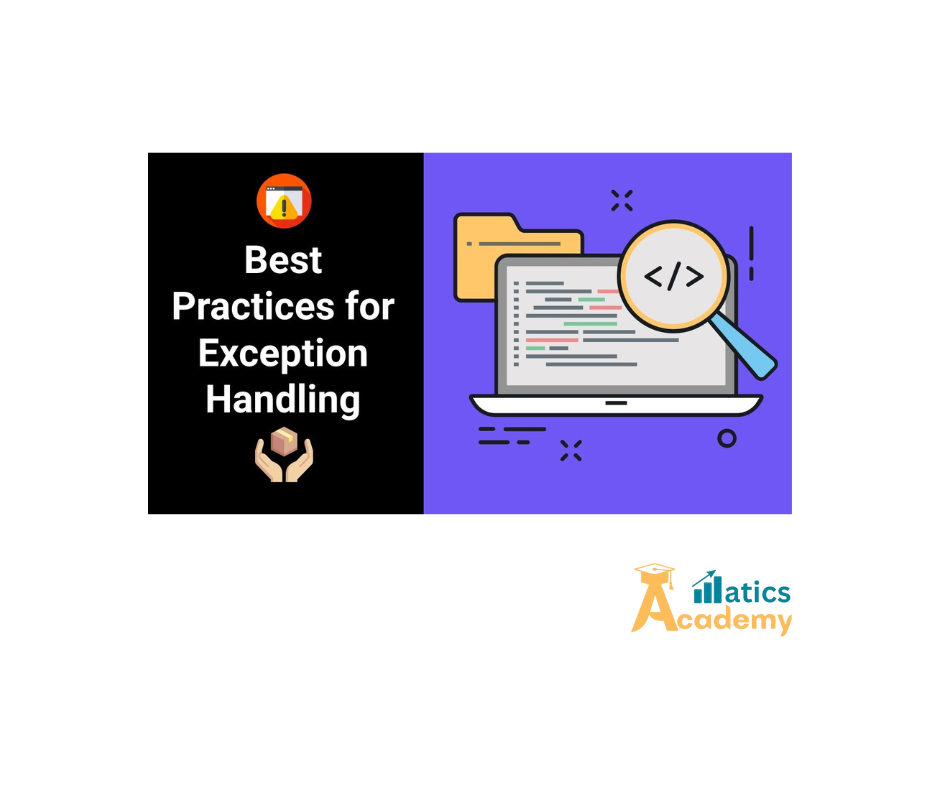1. Introduction of Exception Handling
Understanding exception handling in Java is crucial for developing robust applications. Properly managing errors not only enhances user experience but also improves application stability. This guide covers key concepts, types of exceptions, and best practices in Java.

2. What is Exception Handling?
Exception handling manages runtime errors, enabling the program to continue running smoothly instead of crashing. In Java, exceptions are categorized as either checked or unchecked.
- Checked Exceptions: Must be declared in the method signature or handled within the method.
- Unchecked Exceptions: Do not need to be declared and often occur due to programming errors.
3. Types of Exceptions in Java
- ArithmeticException: Occurs during arithmetic operations, such as dividing by zero.
- NullPointerException: Triggered when attempting to use an object reference that has not been initialized.
- ArrayIndexOutOfBoundsException: Happens when accessing an invalid index of an array.
- ClassNotFoundException: Occurs when the application tries to load a class that cannot be found.
Code Example: Handling ArithmeticException
public class ArithmeticExample {
public static void main(String[] args) {
try {
int result = 10 / 0; // This will throw ArithmeticException
} catch (ArithmeticException e) {
System.out.println("Error: Cannot divide by zero!");
}
}
}Code Example: Handling NullPointerException
public class NullPointerExample {
public static void main(String[] args) {
String str = null;
try {
System.out.println(str.length()); // This will throw NullPointerException
} catch (NullPointerException e) {
System.out.println("Error: String is null!");
}
}
}4. How to Handle Exceptions
In Java, exceptions can be handled using the try-catch block:
Code Example: Basic try-catch Block
public class TryCatchExample {
public static void main(String[] args) {
try {
int[] numbers = {1, 2, 3};
System.out.println(numbers[5]); // This will throw ArrayIndexOutOfBoundsException
} catch (ArrayIndexOutOfBoundsException e) {
System.out.println("Error: Array index is out of bounds!");
}
}
}Code Example: Multiple Exceptions Handling
public class MultipleCatchExample {
public static void main(String[] args) {
try {
String text = null;
System.out.println(text.length()); // This will throw NullPointerException
int result = 10 / 0; // This will throw ArithmeticException
} catch (NullPointerException e) {
System.out.println("Error: Null pointer exception caught!");
} catch (ArithmeticException e) {
System.out.println("Error: Cannot divide by zero!");
}
}
}Exception vs. Error in Java: Key Differences
Both Exception and Error are subclasses of Throwable in Java, but they serve different purposes.
| Feature | Exception | Error |
|---|---|---|
| Definition | Represents issues that can be handled at runtime. | Represents serious problems that should not be handled. |
| When it Occurs | Due to logic errors, invalid user input, etc. | Due to system failures, memory issues, etc. |
| Examples | NullPointerException, ArithmeticException, IOException | OutOfMemoryError, StackOverflowError, VirtualMachineError |
| Handling | Can be caught and handled using try-catch. | Usually cannot be handled. |
| Recovery | The program can recover and continue running. | The program typically crashes. |
📌 Hierarchy of Throwable in Java
Throwable
│
├── Exception (Recoverable issues)
│ ├── Checked Exception (e.g., IOException)
│ ├── Unchecked Exception (e.g., NullPointerException)
│
└── Error (System-level failures)
├── OutOfMemoryError
├── StackOverflowError🚀 throws vs. throw vs. Throwable
| Keyword | Description | Usage |
|---|---|---|
throws | Declares exceptions a method might throw. | Used in method signatures. |
throw | Manually throws an exception. | Used inside methods to trigger exceptions. |
Throwable | The parent class of all exceptions and errors. | Used for catching both errors and exceptions. |
📌 throws Example
✅ Declares that a method may throw an exception
javaCopyEditvoid readFile() throws IOException {
FileReader file = new FileReader("file.txt");
}📌 throw Example
✅ Manually throws an exception inside a method
void validateAge(int age) {
if (age < 18) {
throw new IllegalArgumentException("Age must be 18+");
}
}📌 Throwable Example
✅ Catches both exceptions and errorstry
try{
int result = 10 / 0;
}
} catch (Throwable t) {
System.out.println("Caught: " + t);🚀 Summary
| Feature | throws | throw | Throwable |
|---|---|---|---|
| Purpose | Declares exceptions in method signature | Manually throws an exception | Parent class for exceptions and errors |
| Usage | After method name (throws IOException) | Inside method (throw new Exception()) | Used in catch(Throwable t) |
| Example | void test() throws IOException | throw new NullPointerException(); | catch (Throwable t) |
5. Best Practices for Exception Handling
Use Specific Exceptions:Instead of catching generic exceptions like Exception or Throwable, always aim to catch specific exceptions such as FileNotFoundException, IOException, or ArithmeticException. By doing so, you make it clearer what kind of error occurred, which improves the readability of your code and helps other developers (or yourself) understand the root cause of an issue. For instance, if you’re dealing with file input/output operations, catching IOException allows you to handle only file-related errors, while avoiding the unnecessary handling of unrelated exceptions like NullPointerException. Thus, using specific exceptions ensures more precise error handling, allowing for tailored responses to different error conditions.
Code Example: Custom Exception Handling
public class TestCustomException {
public static void main(String[] args) {
try {
throw new CustomException("This is a custom exception message!");
} catch (CustomException e) {
System.out.println(e.getMessage());
}
}
}public class CustomException extends Exception {
public CustomException(String message) {
super(message);
}
}- Avoid Swallowing Exceptions: Do not leave catch blocks empty. Always log or handle exceptions appropriately.
- Use Finally Block: Utilize the
finallyblock to execute code that should run regardless of whether an exception occurred.
Code Example: try-catch-finally
public class FinallyExample {
public static void main(String[] args) {
try {
int result = 10 / 0; // This will throw ArithmeticException
} catch (ArithmeticException e) {
System.out.println("Error: Cannot divide by zero!");
} finally {
System.out.println("This block always executes.");
}
}
}In Java, exceptions can be handled using the try-catch block:
try {
// Code that may throw an exception
int result = 10 / 0;
} catch (ArithmeticException e) {
System.out.println("Error: " + e.getMessage());
}6. Conclusion
In conclusion, mastering exception handling in Java is crucial for writing clean, error-resistant code. By understanding the different types of exceptions and implementing best practices, developers can create more resilient applications. Additionally, handling exceptions properly ensures that your program behaves as expected even when things go wrong. Moreover, it allows for easier debugging and maintenance, ultimately improving the overall quality of the software. Thus, mastering exception handling not only enhances your coding skills but also contributes to building more robust, user-friendly applications. In the end, it’s a skill that every Java developer must prioritize.
7. Common Interview Questions
1. What is the difference between checked and unchecked exceptions?
- Explanation: Checked exceptions are checked at compile time, meaning the compiler ensures they are either caught or declared in the method signature. Unchecked exceptions, like
RuntimeExceptionand its subclasses, are not checked at compile time and only occur during runtime. - Companies: Oracle, Wipro, Capgemini
2. Why are checked exceptions mandatory to handle or declare, while unchecked exceptions are not?
- Explanation: Checked exceptions represent conditions that a reasonable application should anticipate and recover from (like
IOException), whereas unchecked exceptions typically indicate programming errors (likeNullPointerException) that may not be recoverable. - Companies: IBM, Infosys, TCS
3. How do you create a custom exception in Java? Provide an example.
- Explanation: You can create a custom exception by extending
Exception(for a checked exception) orRuntimeException(for an unchecked exception). Custom exceptions allow you to handle specific application scenarios with detailed error messages. - Companies: Amazon, Microsoft, Google
4. What is the finally block, and how does it differ from the catch block?
- Explanation: The
finallyblock executes after atry-catchstatement, regardless of whether an exception was thrown or caught. - Companies: Accenture, Cognizant, JPMorgan Chase
5. Can you explain the concept of exception chaining in Java?
- Explanation: Exception chaining allows one exception to be linked to another, providing context on an underlying cause of an error. This is done by passing a “cause” exception to a new exception’s constructor, making it easier to trace error origins.
- Companies: Tech Mahindra, Mindtree, Deloitte
8. Additional Resources
- Books: Effective Java by Joshua Bloch.
- Documentation: Visit the Java Exception Handling Documentation for detailed information.
- Tools: Use IDEs with debugging tools to effectively manage exceptions.
PLAY WITH JAVA..!!
Question
Your answer:
Correct answer:
Your Answers
